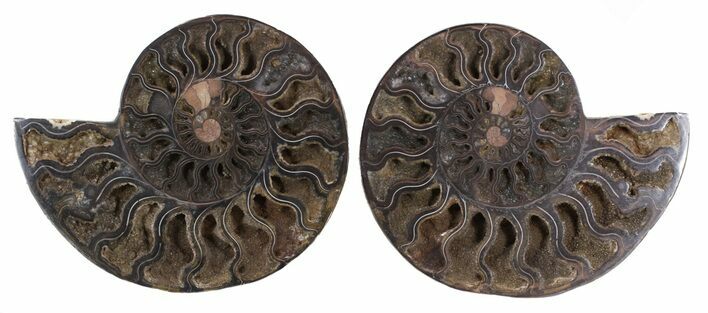This Specimen has been sold.
7.9 Split Black/Orange Ammonite Pair - Unusual Coloration
Here is a unusually colored, cut and polished Cleoniceras ammonite fossil from the Mahajanga Province, Madagascar. It's Early Cretaceous (Albian Stage) in age, or approximately 110 million years old. Both halves are included and they come with a pair of acrylic display stands.
Most ammonites preserve in shades of brown or yellow, so this unique orange and black coloration is quite unusual. These have been collected from a different location and the difference in coloration would be due to changes to the local geochemistry after the ammonite was fossilized. The colors seen here were probably caused by the addition of manganese. You'll notice some of the attached matrix on the back side is a deep orange color instead of the typical grey from the other localities, further hinting at these changes.
About Ammonites
Ammonites were ancient marine cephalopods, similar to today's squids and octopuses, but with a defining feature: their distinctive, tightly coiled spiral shells. These shells, resembling those of modern nautiluses, served as both a protective home and a buoyancy aid, allowing ammonites to navigate the prehistoric seas with ease. First emerging around 240 million years ago in the Triassic Period, ammonites thrived for over 175 million years, adapting through numerous forms and sizes. As predatory creatures, they likely fed on smaller marine organisms, using their tentacles to capture prey. However, their long reign came to an end 65 million years ago at the close of the Cretaceous, coinciding with the mass extinction event that also eliminated the dinosaurs.
Ammonites were ancient marine cephalopods, similar to today's squids and octopuses, but with a defining feature: their distinctive, tightly coiled spiral shells. These shells, resembling those of modern nautiluses, served as both a protective home and a buoyancy aid, allowing ammonites to navigate the prehistoric seas with ease. First emerging around 240 million years ago in the Triassic Period, ammonites thrived for over 175 million years, adapting through numerous forms and sizes. As predatory creatures, they likely fed on smaller marine organisms, using their tentacles to capture prey. However, their long reign came to an end 65 million years ago at the close of the Cretaceous, coinciding with the mass extinction event that also eliminated the dinosaurs.
SPECIES
Cleoniceras
LOCATION
Ambatolafia, Mahajanga Province, Madagascar
SIZE
7.9" wide (each half)
CATEGORY
SUB CATEGORY
ITEM
#55732
We guarantee the authenticity of all of our specimens.
 Reviews
Reviews












